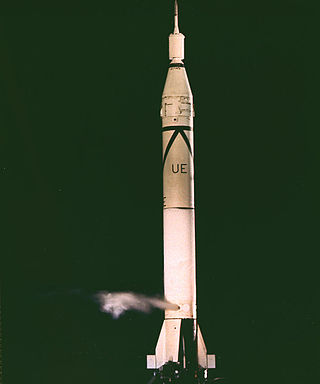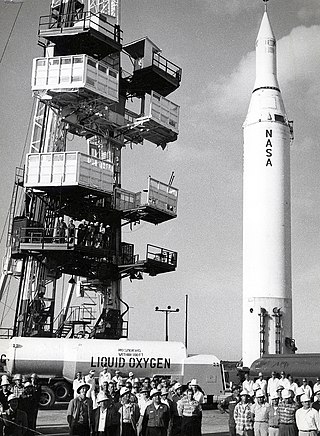
Explorer 1 was the first satellite launched by the United States in 1958 and was part of the U.S. participation in the International Geophysical Year (IGY). The mission followed the first two satellites the previous year; the Soviet Union's Sputnik 1 and Sputnik 2, beginning the Cold War Space Race between the two nations.

The Juno I was a four-stage American space launch vehicle, used to launch lightweight payloads into low Earth orbit. The launch vehicle was used between January 1958 to December 1959. The launch vehicle is a member of the Redstone launch vehicle family, and was derived from the Jupiter-C sounding rocket. It is commonly confused with the Juno II launch vehicle, which was derived from the PGM-19 Jupiter medium-range ballistic missile. In 1958, a Juno I launch vehicle was used to launch America's first satellite, Explorer 1.

Vanguard TV-3, was the first attempt of the United States to launch a satellite into orbit around the Earth, after the successful Soviet launches of Sputnik 1 and Sputnik 2. Vanguard TV-3 was a small satellite designed to test the launch capabilities of the three-stage Vanguard and study the effects of the environment on a satellite and its systems in Earth orbit. It was also to be used to obtain geodetic measurements through orbit analysis. Solar cells on Vanguard TV-3 were manufactured by Bell Laboratories.
Project Vanguard was a program managed by the United States Navy Naval Research Laboratory (NRL), which intended to launch the first artificial satellite into low Earth orbit using a Vanguard rocket. as the launch vehicle from Cape Canaveral Missile Annex, Florida.

Delta II was an expendable launch system, originally designed and built by McDonnell Douglas, and sometimes known as the Thorad Delta 1. Delta II was part of the Delta rocket family and entered service in 1989. Delta II vehicles included the Delta 6000, and the two later Delta 7000 variants. The rocket flew its final mission ICESat-2 on 15 September 2018, earning the launch vehicle a streak of 100 successful missions in a row, with the last failure being GPS IIR-1 in 1997.

Pegasus is an air-launched launch vehicle developed by Orbital Sciences Corporation (OSC) and now built and launched by Northrop Grumman. Pegasus is the world's first privately developed orbital launch vehicle. Capable of carrying small payloads of up to 443 kg (977 lb) into low Earth orbit, Pegasus first flew in 1990 and remains active as of 2021. The vehicle consists of three solid propellant stages and an optional monopropellant fourth stage. Pegasus is released from its carrier aircraft at approximately 12,000 m (39,000 ft), and its first stage has a wing and a tail to provide lift and altitude control while in the atmosphere. Notably, the first stage does not have a thrust vector control (TVC) system.

Titan IV was a family of heavy-lift space launch vehicles developed by Martin Marietta and operated by the United States Air Force from 1989 to 2005. Launches were conducted from Cape Canaveral Air Force Station, Florida and Vandenberg Air Force Base, California.
Explorer 3 was an American artificial satellite launched into medium Earth orbit in 1958. It was the second successful launch in the Explorer program, and was nearly identical to the first U.S. satellite Explorer 1 in its design and mission.
The Vanguard rocket was intended to be the first launch vehicle the United States would use to place a satellite into orbit. Instead, the Sputnik crisis caused by the surprise launch of Sputnik 1 led the U.S., after the failure of Vanguard TV-3, to quickly orbit the Explorer 1 satellite using a Juno I rocket, making Vanguard 1 the second successful U.S. orbital launch.

Viking was a series of twelve sounding rockets designed and built by the Glenn L. Martin Company under the direction of the U.S. Naval Research Laboratory (NRL). Designed to supersede the German V-2, the Viking was the most advanced large, liquid-fueled rocket developed in the United States in the late 1940s, returning valuable scientific data from the edge of space between 1949 and 1955. Viking 4, launched in 1950, was the first sounding rocket to be launched from the deck of a ship.

The Minotaur is a family of United States solid fuel launch vehicles derived from converted Minuteman and Peacekeeper intercontinental ballistic missiles (ICBM). They are built by Northrop Grumman via contract with the Air Force Space and Missile Systems Center's Space Development and Test Directorate (SMC/SD) as part of the Air Force's Rocket Systems Launch Program which converts retired Intercontinental Ballistic Missiles into space and test launch systems for U.S. government agencies.

Juno II was an American space launch vehicle used during the late 1950s and early 1960s. It was derived from the Jupiter missile, which was used as the first stage.

Vanguard TV-3BU, also called Vanguard Test Vehicle-Three Backup, was the second flight of the American Vanguard rocket. An unsuccessful attempt to place an unnamed satellite, Vanguard 1B, into orbit, the rocket was launched on 5 February 1958. It was launched from LC-18A at the Cape Canaveral Air Force Station. Fifty-seven seconds after launch, control of the vehicle was lost, and it failed to achieve orbit. At 57 seconds, the booster suddenly pitched down. The skinny second stage broke in half from aerodynamic stress, causing the Vanguard to tumble end-over-end before a range safety officer sent the destruct command. The cause of the failure was attributed to a spurious guidance signal that caused the first stage to perform unintended pitch maneuvers. Vanguard TV-3BU only reached an altitude of 6.1 km (3.8 mi), the goal was 3,840 km (2,390 mi).

Astra is an American launch vehicle company based in Alameda, California. Astra was incorporated in October 2016 by Chris Kemp and Adam London. Formerly known in media as "Stealth Space Company", the company formally came out as Astra Space, Inc. in a Bloomberg L.P. article by Ashlee Vance. Investors include BlackRock, Advance, ACME, Airbus Ventures, Innovation Endeavors, Salesforce co-founder Marc Benioff, former Disney CEO Michael Eisner, and more.

Vanguard TV-0, also called Vanguard Test Vehicle-Zero, was the first sub-orbital test flight of a Viking rocket as part of the Project Vanguard.

Vanguard TV-5, also called Vanguard Test Vehicle-Five, was a failed flight of the American Vanguard rocket following the successful launch of Vanguard 1 on Vanguard TV-4. Vanguard TV-5 launched on 29 April 1958 at 02:53:00 GMT, from Launch Complex 18A at the Cape Canaveral Air Force Station. The rocket was unsuccessful in its attempt to place an unnamed satellite into orbit.

Vanguard SLV-1, also called Vanguard Satellite Launch Vehicle-1 was hoped to be the second successful flight of the American Vanguard rocket following the successful launch of the Vanguard 1 satellite on rocket Vanguard TV-4 in March 1958.

Vanguard SLV-2, also called Vanguard Satellite Launch Vehicle-2 hoped to be the second successful flight of the American Vanguard rocket following successful Vanguard 1 satellite on rocket Vanguard TV-4.

Vanguard SLV-3, also called Vanguard Satellite Launch Vehicle-3 hoped to be the second successful flight of the American Vanguard rocket following successful Vanguard 1 satellite on rocket Vanguard TV-4.

Vanguard SLV-5, also called Vanguard Satellite Launch Vehicle-Five hoped to be the third successful flight of the American Vanguard rocket following the successful Vanguard 2 satellite on rocket Vanguard SLV-4.















